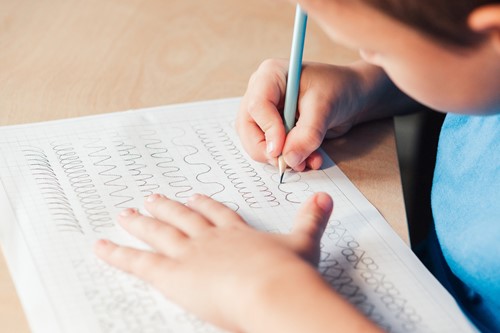At What Age Do Kids Learn How To Write?
Do you remember when your child was able to write their name? It was like yesterday when you watched them with pride and awe while they eagerly took their letters and words and made them come to life on paper.
 Learning how to write is one of those amazing milestones parents often celebrate, but at what age do children begin to comprehend the significance of this ability? How does it progress over time? Let's explore these questions in depth by assessing the average age at which children typically learn how to write and providing suggestions to help your child develop the necessary skills. Continue reading to further understand.
Learning how to write is one of those amazing milestones parents often celebrate, but at what age do children begin to comprehend the significance of this ability? How does it progress over time? Let's explore these questions in depth by assessing the average age at which children typically learn how to write and providing suggestions to help your child develop the necessary skills. Continue reading to further understand.
Writing Milestones By Age
Learning to write is a skill that develops over time – just like walking and talking. Kids start to show interest in writing from age 1, with scribbling and the limitation of letters. As they grow older, they gradually progress through different stages of written language development until they become competent writers.
Still, as much as they develop writing skills at different rates, they are expected to meet certain milestones at a given age. As teachers and parents, you must strive to provide opportunities for building writing habits early and help them develop their fine motor skills. And if you notice a delay, you must consult a paediatrician immediately, as early intervention is paramount. Consider this guide as a reference:
* 12-18 months: Around this age, children may start drawing intentional lines and scribbles. They accomplish this by clenching a crayon or marker in their fist.
* 18 months-2 years: They can grasp writing instruments with their index and middle fingers. Yet, they sketch or scribble using arm movements.
* 2-3 years: At this age, they can hold a crayon with their fingers, but their grip is still developing. This age group should now be able to duplicate drawing vertical and horizontal lines in most circumstances.
* 3-4 years: These are the preschoolers. Drawing is often more appealing than writing at this stage, but they may also begin tracing or copying alphabet letters. They can independently draw vertical and horizontal lines, circles, and intersecting lines. They usually show an interest in writing and will attempt to form letters. They might also start experimenting with their words by developing sounds into symbols.
* 4-5 years: These are older preschoolers. They'll prefer to write with one hand, draw a simple stick figure, or simple shapes, connect dots, and copy their names using fingers and hands to write instead of arm movement.
* 5-6 years: By age five or six, most kids recognise all their letters and enjoy writing games such as ‘make a word’ or ‘write your name’. At this age, they also learn to form words on paper – usually in lower-case letters – without tracing or copying them.
 Stages Of Handwriting Development
Stages Of Handwriting Development
Handwriting development is an essential milestone in a child's development. As children learn to write, read, and communicate more effectively, they gain confidence and develop their unique writing style. Understanding the various stages of handwriting development can help parents, teachers, and other professionals teach and provide appropriate instruction and support during this critical time.
* Pre-Writing Skills
The first stage of handwriting development occurs in the pre-writing phase, typically between the ages of two and four. During this stage, kids develop fine motor skills, spatial awareness, and finger dexterity. This is when they learn to use scissors, draw basic shapes, and correctly hold a
pencil. Pre-writing activities such as colouring and tracing can help children strengthen these skills.
* Letter Formation
Once the pre-writing stage is complete, children move on to letter formation. During this stage, they learn how to form letters correctly and consistently. This is typically seen between the ages of four and seven. Writing on whiteboards or in the sand can help children practice correct letter formation.
* Legibility and Fluency
Once children have mastered the basics of letter formation, they move on to legibility and fluency. This phase is prominent between the ages of seven and ten. During this stage, children learn how to write quickly and accurately. They also work on their letters; spacing, sizing, slanting, and overall appearance. Practice activities such as writing sentences would help children improve their handwriting fluency.
* Developing Personal Style
The final stage of handwriting development is when children develop their style. This phase typically takes place between the ages of ten and twelve. During this time, children refine their handwriting skills and add flair to their writing. They learn to create different handwriting styles,
such as cursive or calligraphy.
Recap
Writing is a skill that many learn at a young age. Some may even start as early as three years old. However, each person’s journey varies when mastering the art of writing. Different approaches can help children learn the structure and mechanics of writing, such as reading plenty of books, attending writing classes, or forming journaling habits. Each child's experiential background and creativity will affect how quickly they hone this skill. For example, a child who loves reading and storytelling and whose parents encourage them may learn the fundamentals faster than one who wasn’t raised in such an environment. So, keep encouraging your kids and guiding them through this incredible process.